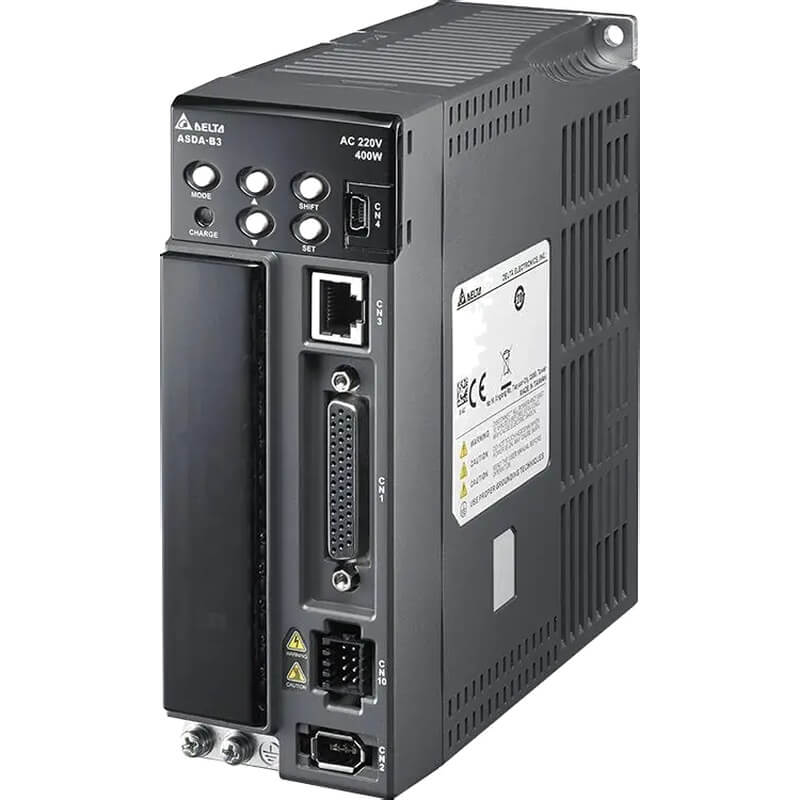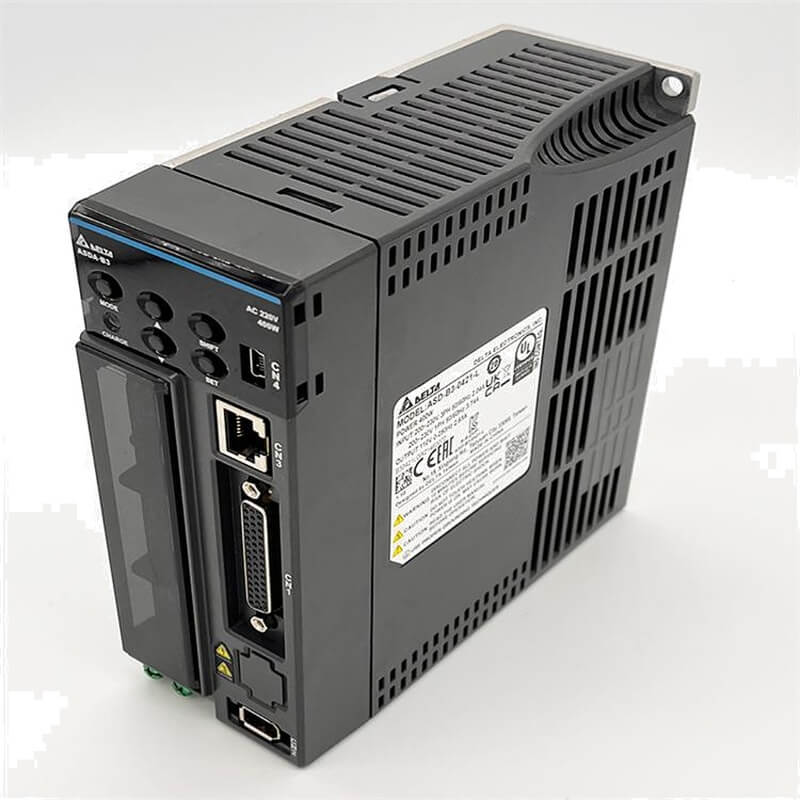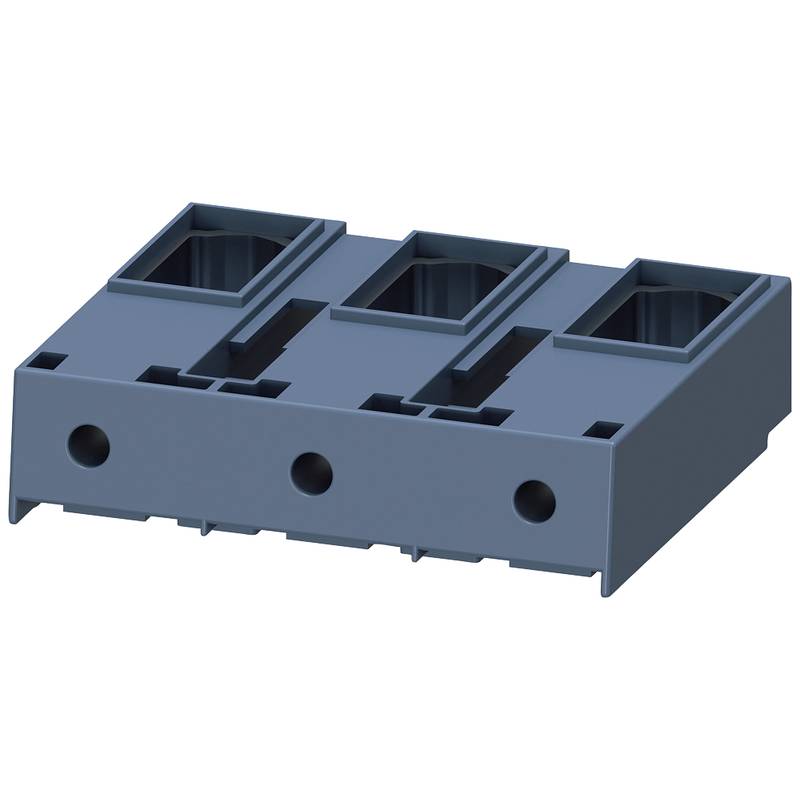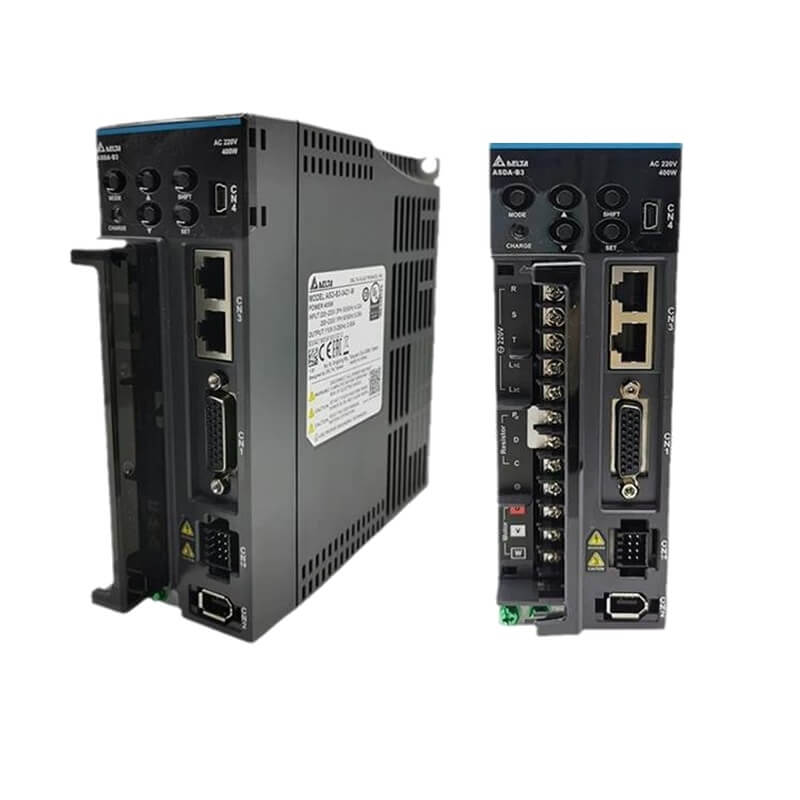
The Delta ASD-B3A-4543-P is a high-performance servo drive engineered for demanding industrial robot systems. This drive delivers exceptional precision and responsiveness, crucial for complex robotic movements. Key advantages include its high bandwidth of 3.1 kHz, enabling rapid motion control and significantly reduced settling times of up to 40% compared to previous generations. The ASD-B3A-4543-P supports 24-bit absolute encoders, ensuring high positioning accuracy and maintaining position data even after power loss. Additionally, it features built-in Safe Torque Off (STO) functionality, compliant with SIL-2 and PL-D safety standards, enhancing operational safety. Core technical parameters include a 4.5kW power output and compatibility with a wide range of communication protocols such as PROFINET, EtherCAT, CANopen, and RS-485. This integration flexibility makes the Delta ASD-B3A-4543-P a robust choice for advanced automation.
Product Specifications
| Feature | Specification |
| :------------------------ | :---------------------------------------------- |
| Series | ASDA-B3 |
| Model Number | ASD-B3A-4543-P |
| Rated Power Output | 4.5 kW |
| Power Input | 3 Phase 380-440 VAC |
| Max Torque | 350% of rated torque |
| Max Speed | 6000 RPM |
| Response Bandwidth | 3.1 kHz |
| Encoder Resolution | 24-bit Absolute Encoder |
| Communication Interfaces | PROFINET, EtherCAT, CANopen, RS-485, Modbus RTU |
| Safety Function | Embedded STO (SIL-2, PL-D) |
| Control Modes | Position, Speed, Torque |
| Settling Time Reduction | Up to 40% |
| Vibration Suppression | Yes |
| Auto-Tuning | Yes |
Core Features & Market Positioning
The Delta ASD-B3A-4543-P distinguishes itself in the industrial robot servo market through its emphasis on high-speed, high-precision motion control and integrated safety features. Its market positioning is that of a premium, yet accessible, solution for manufacturers seeking to enhance robotic performance, reduce cycle times, and ensure operational safety. The drive’s advanced gain adjustment, system analysis, and vibration suppression functions allow for fine-tuning robot movements, leading to smoother operations and extended equipment lifespan. The integration of a 24-bit absolute encoder as standard across the series provides superior positional accuracy compared to older technologies. Furthermore, its compatibility with multiple high-speed communication buses, including PROFINET and EtherCAT, positions it as a versatile component for modern industrial networks, facilitating seamless integration into complex automated systems. This combination of performance, precision, and safety makes the ASD-B3A-4543-P a compelling choice for advanced robotic applications.
Key Application Scenarios
The Delta ASD-B3A-4543-P servo drive is ideally suited for a wide array of industrial robot systems where precision, speed, and reliability are paramount. Its capabilities are leveraged in applications such as:
Assembly Robots: For intricate pick-and-place operations, precise component insertion, and high-speed assembly tasks where even minor deviations can impact product quality. Welding and Dispensing Robots: Ensuring exact path following and consistent speed for uniform welds or precise material application. Material Handling Robots: Facilitating rapid and accurate movement of goods in automated warehouses and logistics centers. Machine Tending Robots: Precisely loading and unloading workpieces from CNC machines and other manufacturing equipment, minimizing cycle times. Automated Inspection Systems: Providing the stable and precise motion required for high-accuracy measurement and quality control.
The drive's robustness and advanced features also make it suitable for sectors including automotive manufacturing, electronics assembly, semiconductor fabrication, and packaging.
Practical System Integration Guidance
Integrating the Delta ASD-B3A-4543-P into an industrial robot system involves careful attention to wiring, parameter configuration, and communication setup. The drive supports various control modes, including Pulse Train, PR Mode, and fieldbus communication protocols like PROFINET and EtherCAT. For seamless integration, it is recommended to use Delta's ASDA-Soft software, which facilitates auto-tuning, parameter setting, and system diagnostics.
When wiring, ensure proper grounding and shielding to prevent electromagnetic interference, especially in environments with high electrical noise. The drive's communication ports (e.g., CN3 for CANopen/RS-485, CN6 for DMCNET) should be connected according to the specific network topology and protocol requirements. The manual provides detailed wiring diagrams for power, control, and communication connections. For PROFINET integration, the drive needs to be configured within the PROFINET network’s engineering software, typically involving GSDML file import and parameter assignment. Similarly, EtherCAT integration requires configuration within the EtherCAT master controller's software.
Operation and Risk Mitigation
Safe operation of the Delta ASD-B3A-4543-P requires adherence to established safety protocols and understanding potential fault conditions. The drive features an embedded Safe Torque Off (STO) function, which immediately removes power to the motor when activated, preventing unexpected movements and complying with safety integrity levels up to SIL-2. It is crucial to ensure that the STO circuit is correctly wired and integrated into the overall safety system of the robot.
Troubleshooting common issues involves monitoring the drive's diagnostic codes. Alarm codes, displayed as "ALxxx", provide insight into operational problems. For instance, over-current (AL001) might indicate a short circuit or motor issue, while encoder-related alarms (e.g., AL018, AL026) point to signal integrity or connection problems. It is essential to consult the ASDA-B3 Series User Manual for a comprehensive list of alarm codes and their corresponding corrective actions. In situations requiring high-precision work, ensuring the encoder signal cable is properly shielded and separated from power cables is vital to prevent interference.
Scalability & Long-Term Value
The Delta ASD-B3A-4543-P is designed for scalability, offering a pathway for future system enhancements and ensuring long-term value. Its compatibility with previous Delta servo series, such as ASDA-A2 and ASDA-A3, allows for phased upgrades and integration into existing infrastructure. The drive supports multiple communication protocols, including EtherCAT, which is highly scalable for multi-axis control and can connect a vast number of axes over long distances with a single wiring setup.
Furthermore, the ASDA-B3 series is forward-looking, supporting integration with Industrial Internet of Things (IIoT) and digital manufacturing initiatives. Advanced functions like system modeling and analysis, coupled with high-speed communication, enable data acquisition for performance monitoring, predictive maintenance, and optimization within smart factory environments. The availability of comprehensive documentation and software tools, such as ASDA-Soft, further supports long-term usability and maintenance.
Frequently Asked Questions (FAQs)
Q1: What are the primary advantages of the Delta ASD-B3A-4543-P for industrial robot systems?
The Delta ASD-B3A-4543-P offers a 3.1 kHz bandwidth for rapid control. It features a 24-bit absolute encoder for high precision. Settling time is reduced by up to 40% for faster operations.
This servo drive includes built-in STO (Safe Torque Off) for enhanced safety. It complies with SIL-2 and PL-D safety standards. This minimizes risks in robotic applications.
It supports multiple communication protocols like PROFINET and EtherCAT. This ensures seamless integration into modern automation networks. Its advanced functions optimize robotic performance.
Q2: Can the Delta ASD-B3A-4543-P be used with different types of industrial robots?
Yes, its high performance makes it suitable for various robots. This includes assembly, welding, and material handling robots. It ensures precise and stable movements for critical tasks.
The drive's flexibility allows integration into custom robotic solutions. Its advanced features cater to specialized industrial automation needs. It enhances robotic capabilities significantly.
Its robust design and safety features ensure reliable operation. This makes it a versatile choice for diverse robotic applications. It can handle demanding operational requirements.
Q3: What are the key technical specifications of the Delta ASD-B3A-4543-P?
This drive has a 4.5 kW rated power output. It operates on a 3-phase 380-440 VAC power supply. It supports a maximum speed of 6000 RPM.
The ASD-B3A-4543-P provides up to 350% maximum torque. It offers a 3.1 kHz response bandwidth. Its 24-bit absolute encoder ensures high accuracy.
It features communication options like PROFINET and EtherCAT. It also includes embedded STO for safety. Position, speed, and torque control modes are supported.
Q4: How does the Delta ASD-B3A-4543-P ensure safety in industrial robot applications?
It features an embedded Safe Torque Off (STO) function. This function immediately cuts motor power. It adheres to SIL-2 and PL-D safety integrity levels.
Correct wiring of the STO circuit into the safety system is vital. This prevents unexpected robot movements during operation or maintenance. It significantly reduces operational hazards.
The STO feature is crucial for compliance with industrial safety regulations. It provides a reliable layer of protection for personnel and equipment. It ensures safe human-robot collaboration.
Q5: What communication protocols does the Delta ASD-B3A-4543-P support for system integration?
The drive supports PROFINET for real-time industrial Ethernet communication. EtherCAT is also supported for high-speed, deterministic communication. CANopen and RS-485 are available for broader network compatibility.
These multiple protocols offer flexibility in system design. They allow seamless integration with various PLCs and industrial controllers. This ensures adaptability to existing infrastructure.
Modbus RTU is another supported protocol for serial communication. This comprehensive suite of communication options makes integration straightforward. It caters to diverse automation network requirements.
Q6: How can the Delta ASD-B3A-4543-P be commissioned and configured?
Configuration is typically done using Delta's ASDA-Soft software. This software enables auto-tuning and parameter setup. It offers a user-friendly graphical interface for ease of use.
Detailed wiring diagrams are provided in the user manual. Proper connection of power, control, and communication cables is essential. Shielding is recommended to prevent interference.
The manual outlines step-by-step procedures for setup. It covers essential steps like encoder setup and network configuration. This ensures a smooth and efficient commissioning process.
Q7: What are some common troubleshooting issues with the Delta ASD-B3A-4543-P and how can they be resolved?
Common issues are indicated by alarm codes (ALxxx). For example, AL001 signifies over-current. This could be due to a short circuit or motor problem.
Encoder-related alarms, like AL018 or AL026, suggest issues with signal integrity. Checking encoder cables and connections is crucial. Proper shielding of these cables is also important.
Referencing the ASDA-B3 Series User Manual is key. It lists all alarm codes and provides specific troubleshooting steps. For persistent issues, contacting Delta support is recommended.
Q8: How does the ASDA-B3 Series offer scalability and long-term value?
Compatibility with older Delta servo series (A2, A3, B2) allows for phased upgrades. EtherCAT support enables scalable multi-axis control over long distances. This facilitates system expansion.
The drive integrates well with IIoT and smart factory initiatives. Its advanced analysis functions support predictive maintenance. This ensures sustained operational efficiency.
Comprehensive documentation and software tools like ASDA-Soft ensure ongoing support. This reduces long-term maintenance costs. It provides a future-proof automation solution.
Q9: What is the importance of the 24-bit absolute encoder in the Delta ASD-B3A-4543-P?
The 24-bit absolute encoder provides extremely high positioning accuracy. It offers over 16.7 million pulses per revolution. This ensures precise motion control for demanding tasks.
It retains position data even when power is lost. This eliminates the need for re-homing upon startup. It significantly reduces downtime and increases productivity.
This high resolution enhances control resolution and system stability. It is crucial for applications requiring meticulous movements. It sets a high standard for robotic precision.
Q10: Can the Delta ASD-B3A-4543-P be used in environments with high electromagnetic interference (EMI)?
Proper installation with shielded cables is recommended. This helps mitigate EMI effects on encoder signals. Following installation guidelines minimizes interference risks.
The drive is designed for industrial environments. However, careful wiring and grounding practices are essential. This ensures reliable performance even in noisy settings.
Adherence to best practices in control cabinet design and cable routing is key. This prevents signal degradation and ensures optimal operation. It guarantees system stability and accuracy.























